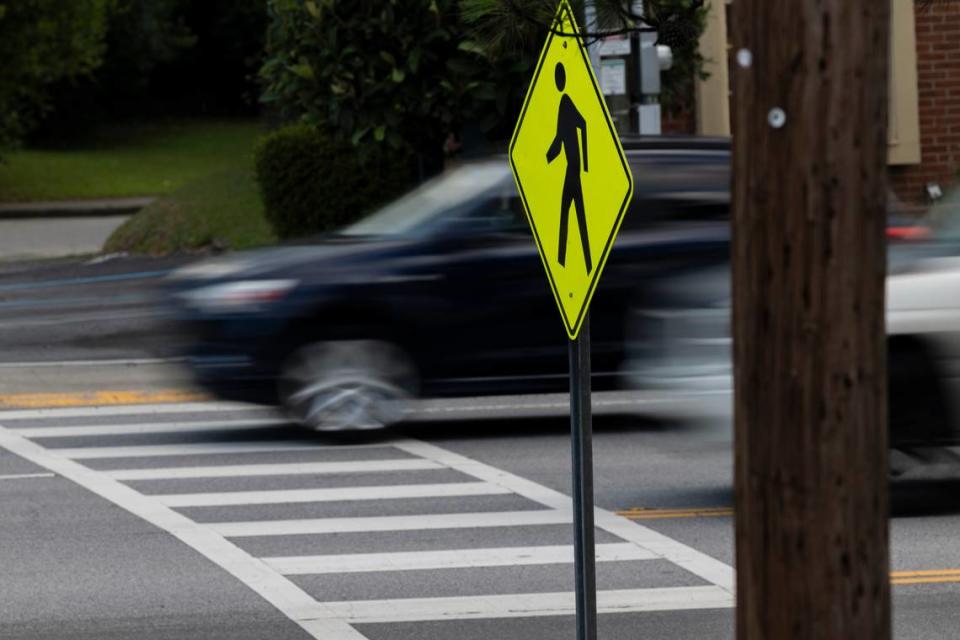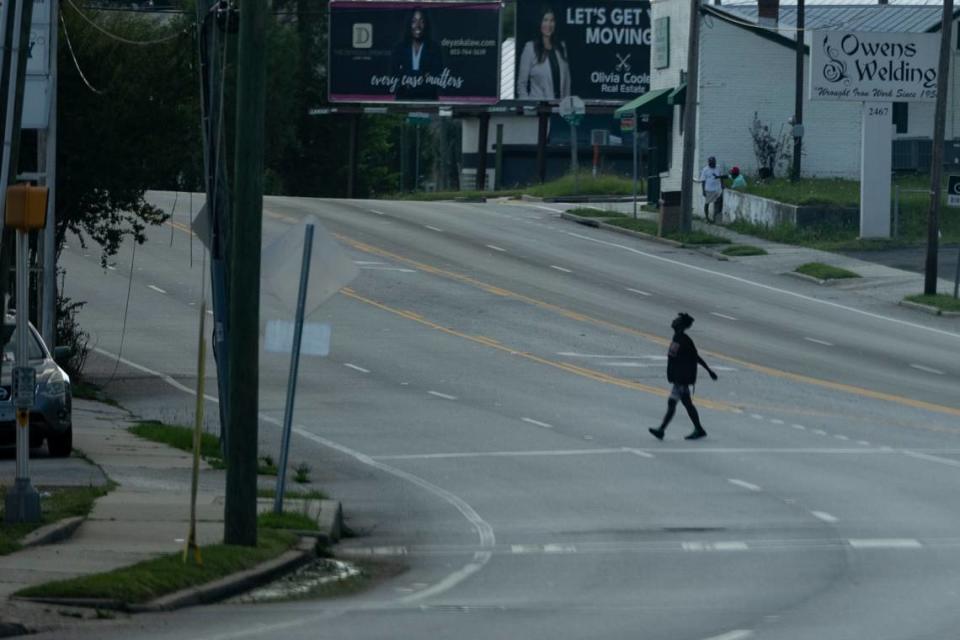Why are South Carolina cities so dangerous for pedestrians?
Patricia Wolfe was hit by a car just before 8 o’clock on a February morning as she walked to class at Columbia International University. The counseling graduate student was remembered as always smiling. She left a husband — and boxes, still unpacked from their move to Columbia. The driver was going “too fast for conditions,” according to police.
Six-year-old Kayden Valdez was killed in a hit-and-run after he reportedly slipped away from his mother at a family birthday party on Percival Road. The driver was never found.
A former high school baseball player, just 19 years old, who was planning to become an electrician was hit by a car near the heart of USC’s campus. In a memorial, Hudson Schiarra’s family remembered him for his faith and his infectious smile. His kindergarten teacher once said he made “life fun.”
The three deaths are tragic examples of Columbia being among the most dangerous cities in America for pedestrians. South Carolina’s capital is tied for 12th, with 144 deaths in the Columbia metropolitan area between 2018 and 2022, according to a new study by Smart Growth America. The cities of Charleston and North Charleston ranked ninth, with 147 total deaths.
Smart Growth America, a nonprofit whose mission is to help local governments build more livable cities, released the rankings in a report published earlier this month.
South Carolina ranks among the most dangerous states for drivers. In 2022, the most recent year for which the National Highway Transportation Safety Administration has published data, South Carolina ranked fifth for all road deaths per hundred thousand residents. It ranked first in deaths per one hundred million miles driven.
But the consequences of the carnage are most felt in urban areas, said Kelly Thomas, a spokesperson for the South Carolina Department of Transportation.
Between 2018 and 2022, 3.46 pedestrians per hundred thousand residents were killed in traffic accidents each year in Columbia, according to the report.
For those who walk, bike or rely on public transportation around Columbia, none of this comes as a surprise.
“I take my life in my hands every time I cross Assembly Street,” said Jean Denham, president of Columbia-based Citizens for Safe Streets, a group that advocates for greater pedestrian safety in South Carolina. The six-lane Assembly Street separates the State House and Columbia’s Main Street from the Vista retail and restaurant district.
When Columbia’s road system was established in 1786, the city’s planners never could have imagined that the streets they laid down would one day be used to usher cars through the city as quickly as possible and onto the highways that now surround South Carolina’s capital.
And by the 1960s and 70s, Columbia had followed in the path of many American cities in deciding that downtowns were something to be driven though. Urban renewal saw streets like Assembly and Huger widened to six lanes and interstates on ramps to downtown Columbia.
Making the streets safer is not simple, say politicians, planners and law enforcement. It requires changing the behavior of drivers and pedestrians, fixing old infrastructure and examining the laws that police the roads.
More broadly, it will require those in charge of South Carolina’s cities to re-imagine how roads are used and who they are for.
“I think we’ve gotten into a bad habit of arranging our lives and quality of life around cars,” said state Rep. Seth Rose, D-Richland, who has led a number of high profile projects to redesign and improve safety on Columbia’s roads. “Other places have clearly prioritized walkability and bikeability as opposed to how many cars can we move through an area.”
Dangerous by design?
After almost 12 years with the Columbia Police Department, Orlando Santos Maduro, a lance corporal with the Traffic Safety Unit, has a special insight into how design impacts safety.
“The human body is just not built to withstand a car traveling 35 miles per hour,” Santos Maduro said. Roads also often fail to take into account human behavior, he said.
The most recent pedestrian death under investigation in Columbia results from an accident Tuesday night on Rosewood Drive, a major in-town corridor. A car hit a 47-year-old man who was crossing the four-lane street near South Edisto Ave. about 11:30 p.m.
While deaths in downtown areas, like Elmwood, Assembly or Five Points — where then U.S. Sen. Strom Thurmond’s daughter was killed by a drunk driver in 1993 — gain the most attention, the majority of deaths occur on major roads miles from the city center.
Garners Ferry, Farrow and Two Notch roads are major hotspots in Columbia, Santos Maduro said. All three share similar characteristics: residential areas cut off from businesses by busy roads with limited sidewalks and “insufficient” crosswalks.
“In some places there are so few intersections, most people don’t want to walk 1,000 feet to cross at an intersection. It’s just human nature to try and cross at a more convenient location,” said Tim Keane, the City of Charleston’s director of planning, permitting and engineering.

Experts who spoke with The State all agreed that South Carolina’s growth was part of the rise in fatal collisions. The state’s population grew by 5% between 2017 and 2022, according to the U.S. Census Bureau.
“We’re growing really rapidly. Lots of folks are coming here and it just means more people on the roadways,” Thomas said.
Accidents are more likely at night, especially when pedestrians are wearing dark clothing, while factors like the increasing size of automobiles and distracted driving because of cellphones are also compounding factors, experts say.
South Carolina is also one of only seven states that prohibit red light cameras, which photograph and automatically ticket drivers who run red lights. While defenders of the ban say it protects privacy and prevents predatory ticketing, especially in small “speed trap towns,” Denham argued that failing to punish these drivers encourages a dangerous driving culture.
“Columbia is part of a state that is limiting what the city can do to cut down on the number of fatalities,” Denham said.
And as cities sprawl and pedestrians and cyclists increasingly use roads that were once designed entirely for cars, “conflict” is more likely, Keane said.
This is especially true in lower income neighborhoods where residents rely more on walking and public transportation and where investment in road safety lags behind other areas.
“People who maybe don’t own a car or don’t have easy access to a car, they’re going to be using those streets, and often they’re highways, on a daily basis for their basic survival and absolutely that’s where you see more conflicts than anywhere else,” Keane said.
What’s being done?
In 2019, after four deaths in the preceding five years, a crosswalk was installed at the intersection of Millwood Avenue and House Street. Since the pedestrian activated light went in, there have not been any deaths on that stretch of Millwood, but jaywalking still occurs, said Rose, who secured state funding for the light.
But Rose said that this hasn’t deterred him from finding ways to improve road safety — in the most recent legislative session he secured $3.5 million for an as-yet unspecified project aimed at increasing pedestrian safety on Devine Street.
The goal, many sources said, was slowing down cars without disrupting the flow of traffic. In Charleston, Keane said that among other initiatives, his department is looking to convert more of the Holy City’s one way streets into two-ways in order to help slow traffic.
Some initiatives planned for Columbia include protected bike lanes, installing more sidewalks in communities and even reducing the number of lanes in some places.

“There has been some trepidation about that,” Rose said “‘We’re not going to have four to five lanes for a couple of blocks, is the sky going to fall?’ And what I think people are going to find out is the sky is not going to fall. Actually it’s going to be completely fine, it’s going to look better and it’s going to help citizens.”
But the real solution, said Columbia Mayor Daniel Rickenmann, is to think holistically about roads and communities.
“I just think we have to be more creative,” Rickenmann said. “You’re reinventing the system a little bit, because times have changed.”
Rickenmann laid out an ambitious vision for a Columbia that prioritized pedestrian safety and livability.
But such a major undertaking requires money. Rickenmann said that he is hoping to secure roughly 20% to 25% of Richland County’s Penny Tax extension, approximately a billion dollars. That money would go towards building sidewalks and bike lanes, among other projects, Rickenmann said.
It also means working with stakeholders in communities that surround Columbia and with state officials. Seventy-two percent of the roads in Columbia are controlled by the state, Rickenmann said.
But overall, Rickenmann said that he has seen changing attitudes about road safety among policymakers and planners. While the mayor emphasized that he believed it was essential to keep traffic moving, the purpose of roads was no longer simply to get cars where they are going as quickly as possible, with pedestrian safety as an afterthought.
While it’s easy to be discouraged by the deaths, said Keane of Charleston, “there is the opportunity here to reverse this trend. If we commit to this, we can create streets that are truly open to everyone.”


